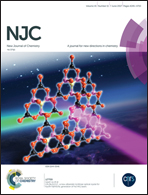Enhanced photocatalytic water splitting by gold carbon dot core shell nanocatalyst under visible/sunlight†
Abstract
Hydrogen production from water using photocatalysts under sunlight still remains a huge challenge. The search for a suitable photocatalyst combines an ability to dissociate water molecules with a band gap that absorbs light in the visible range and also water stability. In this regard, our present study represents a facile method for fabricating carbon quantum dots (CQDs) and Au@CQDs, which are useful for photocatalytic hydrogen generation from water. The optical properties revealed a band gap energy (eV) for CQDs (2.78) and Au@CQDs (2.68); additionally, photoluminescence analysis of CQDs showed maximum emission at 460 nm while also exhibiting a red shift when excited at longer wavelengths. Spherical shaped CQDs, with an average size of 7 nm (d spacing of 0.22 nm), and core shell Au@CQDs, with a shell thickness of 6 nm, were observed by HRTEM analysis. Comparatively, both CQDs (260 μmol) and Au@CQDs (280 μmol) displayed a higher rate of hydrogen production under sunlight irradiation than other carbon materials reported in earlier literature. In photoelectrochemical analysis, current densities associated with Au@CQDs and CQDs photoelectrodes (PEs) were found to be 16 mA cm−2 and 6 mA cm−2, respectively at a very low bias of 0.16 V. Moreover, frequency response analysis (FRA) associated with Randel's equivalent circuit showed that polarization/charge transfer resistance for Au@CQDs was very low (2.74 Ohm) over that of CQDs PEs (88.8 Ohm), which was 12.9 kOhm for bare TiO2 PEs. All these observations indicate that both CQDs and Au@CQDs are ample for preventing an electron–hole recombination processes, which ultimately leads to superior photocatalytic water splitting.



 Please wait while we load your content...
Please wait while we load your content...